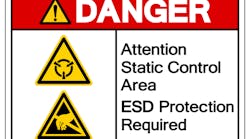Thank you for visiting one of our most popular classic articles. If you’d like to see updated information on this topic, please check out this more recently published article, Combating Electrostatic Damage in the Workplace. |
Electrostatic discharge (ESD) has been around since the beginning of time. However, this natural phenomenon has only become an issue with the widespread use of solid-state electronics.
Sources of ESD
All materials (insulators and conductors alike) are sources of ESD. They are lumped together in what is known as the triboelectric series, which defines the materials associated with positive or negative charges. Positive charges accumulate predominantly on human skin or animal fur. Negative charges are more common to synthetic materials such as Styrofoam or plastic cups. The amount of electrostatic charge that can accumulate on any item is dependent on its capacity to store a charge. For example, the human body can store a charge equal to 250 picofarads. This correlates to a stored charge that can be as high as 25,000V.
How does ESD damage electronic circuitry?
ESD is a tiny version of lightning. As the current dissipates through an object, it's seeking a low impedance path to the ground to equalize potentials. In most cases, ESD currents will travel to the ground via the metal chassis frame of a device. However, it's well known that current will travel on every available path. In some cases, one path may be between the PN junctions on integrated circuits to reach the ground. This current flow will burn holes visible to the naked eye in an integrated circuit, with evidence of heat damage to the surrounding area. One ESD event will not disrupt equipment operation. However, repeated events will degrade the equipment's internal components over time.
How does ESD occur?
ESD can occur in a variety of forms. One of the most common is through human contact with sensitive devices. Human touch is only sensitive on ESD levels that exceed 4,000V.
A recent investigation found the human body and its clothing capable of storing between 500V and 2,500V electrostatic during the normal workday. This is far above the level that damages circuits yet below the human perception threshold. Other sources of ESD damage to equipment include:
- Troubleshooting electronic equipment or handling of printed circuit boards without using an electrostatic wrist strap;
- Placement of synthetic materials (i.e. plastic, Styrofoam, etc.) on or near electronic equipment; and
- Rapid movement of air near electronic equipment (including using compressed air to blow dirt off printed circuit boards, circulating fans blowing on electronic equipment, or using an electronic device close to an air handling system).
In all of these scenarios, the accumulation of static charges may occur, but you may never know. Furthermore, a charged object does not necessarily have to contact the item for an ESD event to occur.
How do you measure electrostatic voltage?
One of the most effective ways to identify potential ESD problem areas is to make measurements using an electrostatic voltmeter. This meter will effectively measure electrostatic voltage up to 30,000V on all conductors and insulators. It also will display whether the charge is negative or positive. This may help you determine the source of the electrostatic accumulation.
How can you prevent ESD?
It's unlikely you can eliminate ESD completely from any site. However, experience has shown that the following guidelines are helpful:
- Keep all synthetic materials at least 4 in. away from electronic equipment.
- When cleaning printed circuit boards, use a spray labeled as non-static forming.
- When troubleshooting electronic equipment, always wear a static wrist strap that's grounded to the frame of the device. Also, wear the wrist strap when handling printed circuit boards.
- Treat carpets and floors with compounds that reduce the buildup of static charges.
- Use static floor mats where necessary.
- Make sure the grounding system for equipment has a low impedance for ESD currents to dissipate to an earthing reference. For more information, refer to NFPA-77, Recommended Practice on Static Electricity.
SIDEBAR: What Is Static Electricity?
It's the accumulation of positive or negative charges on insulators or conductors. These charges can vary, based on the stored capacitance of certain items with respect to an object having a corresponding opposite charge. The word static simply means the charge cannot be equalized or transferred through electromotive force until there is a decrease in the capacitance between two objects. An example of this can be your hand (which may hold a negative charge) as it approaches a doorknob (which may hold a positive charge). As your hand moves closer to the doorknob, the capacitance between the object and your hand will decrease. This results in a flow of current between your hand and the doorknob. This transfer is known as electrostatic discharge or ESD.
For more information, read "Combating Electrostatic Discharge in the Workplace."




